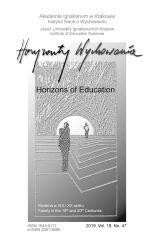Reprezentacje rodziny w poradnikowych gatunkach dziennikarskich. Przykład kobiecej prasy powojennej
Abstract
RESEARCH OBJECTIVE: The aim of the study is to present the mechanisms that postwar journalists used to demonstrate family issues in the women’s press and to analyze these messages on a representative level.
THE RESEARCH PROBLEM AND METHODS: The article highlights family representations that were presented in the women’s press in the years 1946-1947. The author of the work indicates the special significance of this historical period for the development of the press after the war and for the denial of the concept of “pre-war” families. As a research method, the author applied content analysis, genological analysis and literature research.
THE PROCESS OF ARGUMENTATION: In the course of deliberations, the notion of “uncertainty time” and family representation in the press after the end of World War II is discussed. Next, the author touched on the role of the women’s press in the process of shaping awareness about the family in the twentieth century. The decisive part of the study is the analysis of family messages in the context of the media genology and the interpretation of journalistic tools used to highlight specific features. Designated family creations are presented as an opportunity to intensify interest in women’s historical narrative.
RESEARCH RESULTS: Analyzed journalistic tests testify to the domination of affirmation of every-day practicality and emotionality. The messages are constructed in such a way as to provide the reader with the authentic influence of the recipients on the content of the magazine. The predominant journalistic genre appearing in the analyzed material are letters to the editor, often adapted to other journalistic genres, briefings and reports.
CONCLUSION, INNOVATIONS, AND RECOMMENDATIONS: Journalists of the post-war women’s press showed the superiority of the role of women in the family and presented this idea with the help of specific genre tools.
References
Adamski, F. (1980). Modele małżeństwa i rodziny a kultura masowa.
Bednarski, H. (2009). Przemiany struktury i funkcji rodzin polskich w XX i XXI wieku. Mazowieckie studia humanistyczne. s. 198.
Budrowska, B. (2000). Macierzyństwo jako punkt zwrotny w życiu kobiety.
Dziki, S. (1985-1986). Prasa polska w latach 1944-1948. Kwartalnik Historii Prasy Polskiej. 24/1.
Fidelis, M. (2006). Czy nowy matriarchat? Kobiety bez mężczyzn w Polsce po II wojnie światowej. W: A. Żarnowska i A. Szwarc (red.), Kobiety i rewolucja obyczajowa. Społeczno - kulturowe aspekty seksualności. Wiek XIX i XX. 432-435.
Fras, J. (2013). O typologii wypowiedzi medialnych i dziennikarskich.
Gromkowska, A. (2002). Kobiecość w kulturze globalne: rekonstrukcje i reprezentacje. s. 17-18.
Hajdo, M. (2006). Wizerunek kobiety jako matki, pracownika i działaczki społecznej prezentowany na łamach prasy kobiecej w latach 1948-1956. W: Dzieje najnowsze. 57.
Kalinowska-Witek, B. (2014). Rola, zadania i pozycja społeczna mężczyzny i kobiety w rodzinie w świetle wybranych czasopism kobiecych z lat 1864-1914, Wychowanie w Rodzinie. 10. s. 179.
Łozowska-Marcinkowska, K. (2010). Sprawy niewieście: problematyka czasopism kobiecych Drugiej Rzeczpospolitej. s. 133.
Maliszewski, A. (1980). Rodzina w polskich magazynach ilustrowanych. Kraków: OBP „Raporty”.
Markowska, D. (1986). Rola kobiety w polskiej rodzinie. W” E. Konecka (red.), Kobiety polskie.
Skrzypek, J. (1964). Etapy rozwojowe prasy w Polsce Ludowej. Zeszyty Prasoznawcze. 3, 66-67.
Słomkowska, A. (1980). Materialne zniszczenia i straty dziennikarstwa polskiego w wyniku II wojny światowe. W: Prasa w PRL. Szkice historyczne. s. 6.
Sokół, Z. (1998). Prasa kobieca w latach 1945-1995. s. 83.
Sokół, Z. (2003). Przyjaciółka - tygodnik kobiet (1948-1998), część II - lata marzec 1951 - marzec 1990. W: Kieleckie Studia Bibliologiczne. 107.
Sokół, Z. (2000). Wzór osobowy kobiety i model rodziny propagowany na łamach prasy kobiecej w latach 1945-1990. W: W. Chańska i B. Ulicka (red.), Polskie oblicza feminizmu. s. 66-85.
Stańczak-Wiślicz, K. (2010). Opowieści o trudach życia. Narracje zwierzeniowe w popularnej prasie kobiecej XX wieku.
Świda-Ziemba, H. (2003). Urwany lot. Pokolenie inteligenckiej młodzieży w świetle listów i pamiętników z lat 1945-1948.
Wojtak, M. (2004). Gatunki prasowe. 140.
Wolny-Zmorzyński, K., Kaliszewski, A., Snopek, J., Furman, W. (2014). Prasowe gatunki dziennikarskie.
Worsowicz, M. (2018). Gatunki w dziennikarstwie poradnikowym (na przykładzie prasy). Część II. Acta Universitatis Lodziensis. 225.
Zierkiewicz, E. (2002). Prasa kobieca versus pisma feministyczne. Między dobrowolnym zniewoleniem a wymuszoną emancypacją. W: E. Zierkiewicz i I. Kowalczyk (red.), Kobiety w kulturze popularnej. 42.
Copyright (c) 2020 Magdalena Idem

This work is licensed under a Creative Commons Attribution-NoDerivatives 4.0 International License.
Authors who publish in this journal agree to the following terms:
- Authors retain the copyright to their work while granting the journal the right of first publication. The work will be simultaneously licensed under a CC BY-ND license, which permits others to share the work with proper credit given to the author and the original publication in this journal.
- Authors may enter into additional, non-exclusive agreements for the distribution of the published version of the work (e.g., posting it in an institutional repository or publishing it in another journal), provided that the original publication in this journal is acknowledged.
We allow and encourage authors to share their work online (e.g., in institutional repositories or on personal websites) both before and during the submission process, as this can foster beneficial exchanges and lead to earlier and increased citations of the published work. (See The Effect of Open Access). We recommend using any of the following academic networking platforms:





